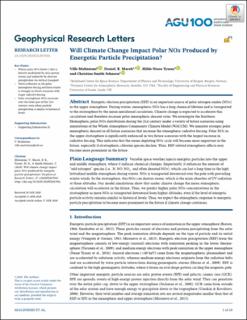Will Climate Change Impact Polar NOx Produced by Energetic Particle Precipitation?
Journal article, Peer reviewed
Published version

Åpne
Permanent lenke
https://hdl.handle.net/11250/2756905Utgivelsesdato
2020Metadata
Vis full innførselSamlinger
Sammendrag
Energetic electron precipitation (EEP) is an important source of polar nitrogen oxides (NOx) in the upper atmosphere. During winter, mesospheric NOx has a long chemical lifetime and is transported to the stratosphere by the mean meridional circulation. Climate change is expected to accelerate this circulation and therefore increase polar mesospheric descent rates. We investigate the Southern Hemispheric polar NOx distribution during the 21st century under a variety of future scenarios using simulations of the Whole Atmosphere Community Climate Model (WACCM). We simulate stronger polar mesospheric descent in all future scenarios that increase the atmospheric radiative forcing. Polar NOx in the upper stratosphere is significantly enhanced in two future scenarios with the largest increase in radiative forcing. This indicates that the ozone depleting NOx cycle will become more important in the future, especially if stratospheric chlorine species decline. Thus, EEP-related atmospheric effects may become more prominent in the future.
